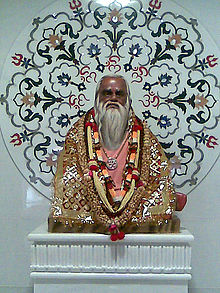Gagangiri Maharaj
Gagangiri Maharaj | |
|---|---|
 Gaganagiri Maharaj Samadhi at Khopoli Ashram | |
| Personal | |
| Born | Shripad Ganpatrao Patankar 30 November 1906 Mandure, Patan, Maharashtra |
| Died | 4 February 2008 |
| Religion | Hinduism |
| Nationality | Indian |
| Honors | Vishva Gaurav, Parliament of the World's Religions |
Swami Gagangiri Maharaj was an Indian
Life
Shri Gagangiri Maharaj was born as Shripad Patankar in a village named Mandure in
After getting initiated in a monastic order he started travelling with various
Gagangiri Maharaj was extremely tired as a result of his peregrinations and he decided to rest in a cave. When he was relaxing, a sage wearing saffron robes came there from the mountains. He sprinkled water from his kamandalu, on the face of Gagangiri Maharaj. He also gave him some kind of green grass to eat which resembled coriander leaves. For his penance, he had prepared mattresses of grass. He found his mattresses growing like living vegetation. This was considered as an experience, where Tantrik technique is perfected. He did a number of Kaya Kalpas. In this process he invented several new concepts in Tantrik techniques and proved them true. He did penance at a number of places like Mauli Kund, Mauli Kada, Zanzu water, Mausame Kada, Kasarbari, Ginger water, Sat-barkund, Holi Kada, Margaj water, Jungledeo patti, Shirale etc.
During monsoon, he stayed in the cave at Garbhagiri, Gagangiri. He did penance in a pond near the river at Sangashi, Vazar, Vesraf, Palsambe, Ramling etc. Later he went to
Swamiji then decided to travel all over India alone on foot and accordingly his journey started. At this time, his fair skin was glowing with health. Attired in saffron robes of a sanyasi, young and wise, Swamiji was revered by people. He travelled on foot from Haridwar to Delhi, Bhopal, etc. At
Teachings
Gagangiri Maharaj was an active environmentalist seer. He preached and spread awareness about the conservation and protection of the environment. His teachings emphasized on living in a harmonious relationship with nature and preserving it.
Ashrams and devotees
Gagangiri Maharaj used to travel between his ashrams in
Maharaj took Mahasamadhi
References
- ^ "पाटणकर, श्रीपाद गणपत". महाराष्ट्र नायक. Retrieved 10 May 2023.
- ^ Hindu Vishva. 1980.
- ^ "Bright and beautiful: Mumbai lit up on Kojagiri Purnima". Hindustan Times. 6 October 2017. Retrieved 10 May 2023.
- ^ ऑनलाईन, सामना (20 April 2022). "गगनगिरी महाराज चॅरिटेबल ट्रस्टच्या जमिनीच्या भाडेपट्ट्याचे नुतनीकरण | Saamana (सामना)". Retrieved 10 May 2023.
- ISBN 9788174765383.
- ISBN 9788174480927.
- ^ "Gagangiri Maharaj dead - Times of India". The Times of India. Retrieved 4 August 2018.
- ^ Sumiet Talekar (29 January 2012), H. H. Gagangiri ~ Maha Nirvaan / Sumiet23, retrieved 4 August 2018
- ^ "अध्यात्मिक गुरू गगनगिरी महाराज यांचे निधन". Maharashtra Times (in Marathi). Retrieved 10 May 2023.
